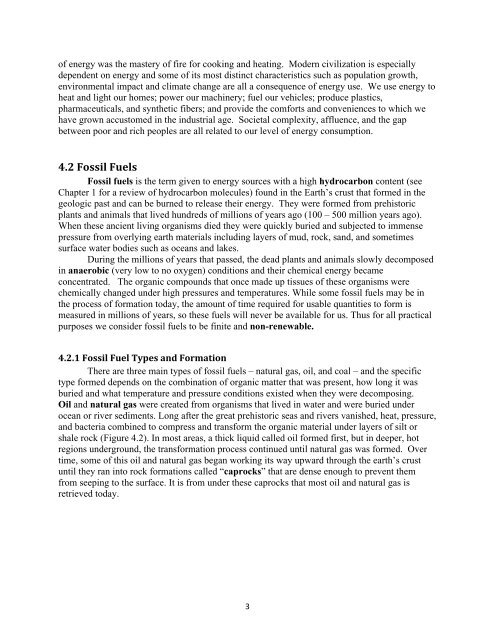Introduction to Environmental Science, 2nd Edition, 2018a
Introduction to Environmental Science, 2nd Edition, 2018a
Introduction to Environmental Science, 2nd Edition, 2018a
You also want an ePaper? Increase the reach of your titles
YUMPU automatically turns print PDFs into web optimized ePapers that Google loves.
of energy was the mastery of fire for cooking and heating. Modern civilization is especially<br />
dependent on energy and some of its most distinct characteristics such as population growth,<br />
environmental impact and climate change are all a consequence of energy use. We use energy <strong>to</strong><br />
heat and light our homes; power our machinery; fuel our vehicles; produce plastics,<br />
pharmaceuticals, and synthetic fibers; and provide the comforts and conveniences <strong>to</strong> which we<br />
have grown accus<strong>to</strong>med in the industrial age. Societal complexity, affluence, and the gap<br />
between poor and rich peoples are all related <strong>to</strong> our level of energy consumption.<br />
<br />
Fossil fuels is the term given <strong>to</strong> energy sources with a high hydrocarbon content (see<br />
Chapter 1 for a review of hydrocarbon molecules) found in the Earth’s crust that formed in the<br />
geologic past and can be burned <strong>to</strong> release their energy. They were formed from prehis<strong>to</strong>ric<br />
plants and animals that lived hundreds of millions of years ago (100 – 500 million years ago).<br />
When these ancient living organisms died they were quickly buried and subjected <strong>to</strong> immense<br />
pressure from overlying earth materials including layers of mud, rock, sand, and sometimes<br />
surface water bodies such as oceans and lakes.<br />
During the millions of years that passed, the dead plants and animals slowly decomposed<br />
in anaerobic (very low <strong>to</strong> no oxygen) conditions and their chemical energy became<br />
concentrated. The organic compounds that once made up tissues of these organisms were<br />
chemically changed under high pressures and temperatures. While some fossil fuels may be in<br />
the process of formation <strong>to</strong>day, the amount of time required for usable quantities <strong>to</strong> form is<br />
measured in millions of years, so these fuels will never be available for us. Thus for all practical<br />
purposes we consider fossil fuels <strong>to</strong> be finite and non-renewable.<br />
<br />
There are three main types of fossil fuels – natural gas, oil, and coal – and the specific<br />
type formed depends on the combination of organic matter that was present, how long it was<br />
buried and what temperature and pressure conditions existed when they were decomposing.<br />
Oil and natural gas were created from organisms that lived in water and were buried under<br />
ocean or river sediments. Long after the great prehis<strong>to</strong>ric seas and rivers vanished, heat, pressure,<br />
and bacteria combined <strong>to</strong> compress and transform the organic material under layers of silt or<br />
shale rock (Figure 4.2). In most areas, a thick liquid called oil formed first, but in deeper, hot<br />
regions underground, the transformation process continued until natural gas was formed. Over<br />
time, some of this oil and natural gas began working its way upward through the earth’s crust<br />
until they ran in<strong>to</strong> rock formations called “caprocks” that are dense enough <strong>to</strong> prevent them<br />
from seeping <strong>to</strong> the surface. It is from under these caprocks that most oil and natural gas is<br />
retrieved <strong>to</strong>day.


















